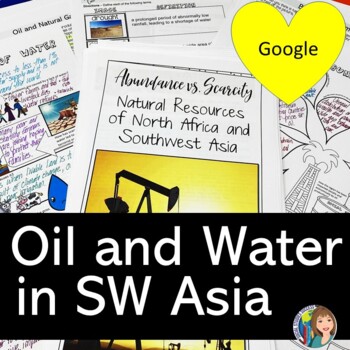Description
What are the natural resources of Southwest Asia and North Africa and how do they impact life in the region? Your students will learn about the abundance of oil and the scarcity of water in the Middle East through a discussion activity.
Students will start with a vocabulary activity with beautiful Word Wall images. Then break your students up into groups of three so you can read and discuss the various ways an abundance of oil and the scarcity of water impact life in Southwest Asia and North Africa. You will have multiple resources to check for understanding throughout the lesson and at the very end. All of the resources are also available on Google Slides™!
With this resource, you will receive:
–Word Wall images to teach the vocabulary,
–Vocabulary chart aligned to the vocabulary terms,
–Vocabulary activity to practice and process the terms,
-An anticipation guide preview activity,
–9 pages of content readings on the impact of the abundance of oil (including OPEC, life in different countries, distribution of wealth, etc.) and the scarcity of water (including the drought, water refugees, rise in terrorism, desalination, desertification, etc.) and questions to drive discussion,
–Doodle Notes™ for oil and water,
–multiple assessments,
-number cards for the structured discussion,
-resources on Google Slides™, and
-an answer key.
⭐Please download the preview to see a portion of the resource. The video will also show you an overview of the resource. ⭐
6th Grade Social Studies TEKS
(3) Geography. The student understands the factors that influence the locations and characteristics of locations of various contemporary societies on maps and/or globes. The student is expected to:
(A) identify and explain the geographic factors responsible for patterns of population in places and regions;
(B) explain ways in which human migration influences the character of places and regions;
(4) Geography. The student understands how geographic factors influence the economic development and political relationships of societies. The student is expected to:
(A) explain the geographic factors responsible for the location of economic activities in places and regions; and
(B) identify geographic factors such as location, physical features, transportation corridors and barriers, and distribution of natural resources that influence a society’s political relationships.
(5) Geography. The student understands the impact of interactions between people and the physical environment on the development and conditions of places and regions. The student is expected to:
(A) describe ways people have been impacted by physical processes such as earthquakes and climate;
(B) identify and analyze ways people have adapted to the physical environment in various places and regions; and
(C) identify and analyze ways people have modified the physical environment such as mining, irrigation, and transportation infrastructure.
(6) Economics. The student understands the factors of production in a society’s economy. The student is expected to:
(A) describe ways in which the factors of production (natural resources, labor, capital, and entrepreneurs) influence the economies of various contemporary societies;
(B) identify problems that may arise when one or more of the factors of production is in relatively short supply; and
(C) explain the impact of the distribution of resources on international trade and economic interdependence among and within societies.
(18) Science, technology, and society. The student understands the influences of science and technology on contemporary societies. The student is expected to:
(A) identify examples of scientific discoveries, technological innovations, and scientists and inventors that have shaped the world;
(B) explain how resources, economic factors, and political decisions affect the use of technology; and
(C) make predictions about future social, political, economic, cultural, and environmental impacts that may result from future scientific discoveries and technological innovations.
(21) Social studies skills. The student applies critical-thinking skills to organize and use information acquired through established research methodologies from a variety of valid sources, including electronic technology. The student is expected to:
(A) differentiate between, locate, and use valid primary and secondary sources such as computer software; interviews; biographies; oral, print, and visual material; and artifacts to acquire information about various world cultures;
(B) analyze information by sequencing, categorizing, identifying cause-and-effect relationships, comparing, contrasting, finding the main idea, summarizing, making generalizations and predictions, and drawing inferences and conclusions;
(C) organize and interpret information from outlines, reports, databases, and visuals, including graphs, charts, timelines, and maps; and
(20) Social studies skills. The student uses geographic tools to collect, analyze, and interpret data. The student is expected to:
(A) answer geographic questions, including: Where is it located? Why is it there? What is significant about its location? How is its location related to the location of other people, places, and environments? Using latitude and longitude, where is it located?;
(B) pose and answer questions about geographic distributions and patterns for various world regions and countries shown on maps, graphs, and charts;
(C) compare various world regions and countries using data from maps, graphs, and charts; and
(21) Social studies skills. The student communicates in written, oral, and visual forms. The student is expected to:
(A) use social studies terminology correctly;
(B) incorporate main and supporting ideas in verbal and written communication based on research;
(C) express ideas orally based on research and experiences;
(D) create written and visual material such as journal entries, reports, graphic organizers, outlines, and bibliographies based on research; and
Doodle notes is a trademarked term used with permission. Please visit doodlenotes.org for more information.















Reviews
There are no reviews yet.